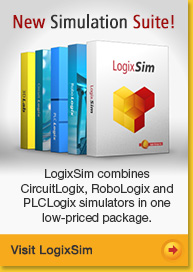
QUESTION: What is CircuitLogix?
ANSWER: CircuitLogix is a software program that converts your personal computer into a fully-functioning electronics laboratory with thousands of components and devices that are easily interconnected.
QUESTION: If I am an electronics student, how can I benefit from CircuitLogix?
ANSWER: The student version of CircuitLogix is available as a free download for anyone who is studying electronics. Circuit files to accompany the major electronics textbooks used in colleges and universities are also available as a free download for students. So, as a student, you have free access to both the simulation software and hundreds of pre-built electronic circuits.
QUESTION: What is the difference between the Student Version and Full Version of CircuitLogix?
ANSWER: CircuitLogix Student Version is intended strictly for use by students on their personal computer. The full version of CircuitLogix can be used by schools, educational institutions, training organizations, etc. While the core products are the same, the full version of CircuitLogix has additional models and other simulation and export features that are not in the student version. One of the main differences between the student and full version is that the full version includes 3DLab, which is a virtual-reality lab environment for introductory-level circuits and experiments.
QUESTION: What documentation is included with CircuitLogix?
ANSWER: Every copy of the full version of CircuitLogix includes a comprehensive printed User Manual and Device Library Guide. There is no hardcopy documentation provided with the student version. However, a comprehensive online student resource center provides access to online documentation for all CircuitLogix users.
QUESTION: What devices are included in CircuitLogix?
ANSWER: CircuitLogix contains over 4000 device models. These devices include semiconductors, displays, indicators, switches, digital primitives, digital ICs, linear ICs, transistors, FETs, optoisolators, photo diodes, regulators, references, SCRs, triacs, supplies, sources, relays, math devices, transmission lines, motors, etc. In addition, a full suite of virtual instruments are provided including oscilloscope, digital multimeter, Bode plotter, curve tracer, data sequencer, signal generator, logic analyzer, logic probe and logic pulser.
QUESTION: How does CircuitLogix compare to other simulators?
ANSWER: CircuitLogix is the only electronics lab simulator designed specifically for the education market. Our free student version created a revolution in electronics laboratory simulation, and has made us the world-leader in the electronics education market. The highly intuitive graphic-user-interface provides easy operation, without sacrificing its powerful processing capabilities. CircuitLogix meets or exceeds the functionality of its leading competitors while providing a more user-friendly interface. In most cases, you'll find that CircuitLogix is easier to use and provides as many or more features than products costing up to 10 times as much as our full version.
QUESTION: What other related products are available?
ANSWER: A full suite of learning products to accompany CircuitLogix are available through Logic Design Inc. These products include computer-based training, textbooks, and testing and assessment. Other lab simulators, such as LogixPro PLC simulation is also available. While CircuitLogix provides a certain level of electro-mechanical simulation and ladder logic control, LogixPro provides advanced levels of ladder logic simulation.
QUESTION: What electronics education programs are available that use CircuitLogix?
ANSWER: A complete listing of online electronics and electro-mechanical programs using CircuitLogix in your local state or province is available at the following link: www.online-tech-training.com. One of the largest and most popular distance education electronics programs in the world is offered by George Brown College in Toronto, Canada. The George Brown Electronics Technician distance education program currently has over 6,000 students enrolled from over 27 countries. Information about this program is available at www.etcourse.com.
QUESTION: What is SPICE?
ANSWER: SPICE is an acronym that stands for Simulation Program (with) Integrated Circuit Emphasis. The program has become the industry de facto standard for analog circuit simulation and was developed at Berkeley University. CircuitLogix uses an enhanced version of XSPICE and 3fSpice to perform its simulation.
QUESTION: Why is that important to me?
ANSWER: There are several important reasons. First, since SPICE is the industry standard for analog simulation there are many third party books and other reference materials available to assist the user. Whether you are a beginner or professional, there are aids which can help you reach a higher level of simulation accuracy and performance. Second, many manufacturers make SPICE compatible libraries of their devices available on diskette. These libraries can be easily imported into CircuitLogix to expand the included device libraries.
QUESTION: How is CircuitLogix's version of SPICE different?
ANSWER: Many of the SPICE simulation programs available today are difficult to use and have serious limitations. At Logic Design Inc. we have greatly enhanced SPICE and removed the difficulty of use. In fact, unless you choose, you may not even be aware that SPICE is involved in the simulation. With CircuitLogix everything is setup using the intuitive graphical user interface. Finally, even though we have enhanced SPICE, CircuitLogix remains 100% SPICE compatible.
QUESTION: What if I need a device that is not in the provided library?
ANSWER: There are three main methods of expanding CircuitLogix's device library. The first method involves importing SPICE models and macro models. Many device manufacturers provide SPICE models for their devices on disk or over the internet. In fact, our LINKS page has internet links to many manufacturer websites where SPICE models can be found. SPICE models can be quickly and easily imported into CircuitLogix to expand the included device libraries. The second method of adding new devices is through the powerful Macro creation feature. This method involves building a circuit using existing devices which functions equivalent to the needed device. This circuit is then encapsulated into a package of the users choice and saved in the library for future use. Macros can be expanded at any time, edited, and resaved. The third method of adding devices is for those who own the full version of CircuitLogix. This version supports SimCode®, a high-level programming language that allows you to write your own digital models quickly and accurately.
QUESTION: Is CircuitLogix compatible with other PCB layout tools? What format does CircuitLogix export its PCB netlist in?
ANSWER: CircuitLogix is compatible with many standard PCB layout software. CircuitLogix outputs PCB netlists in variety of formats, including Tango, Protel, OrCAD PCB II, PADS PCB and others.
QUESTION: What are the future plans/upgrade policies for CircuitLogix?
ANSWER: Logic Design Inc. is continually developing and enhancing its product line to meet the needs of our customers. New version releases can be expected about every 12-18 months. We offer very affordable upgrade options for registered users of our Full Version of CircuitLogix, but unlike most companies, we do not "penalize" customers if they choose to skip an upgrade and wait for the next one. And if you purchase one of our products within 90 days of a new version release, we will provide you the upgrade for free, so you don't have to worry about purchasing at the "wrong" time. If you have any comments or suggestions for future releases, please let us know. Our research and development is driven largely by customer input.
Additional Questions? Please see our Student Resources page for more technical details on CircuitLogix. If the answer you need is not there, you can contact for email support at techsupport@CircuitLogix.com.





